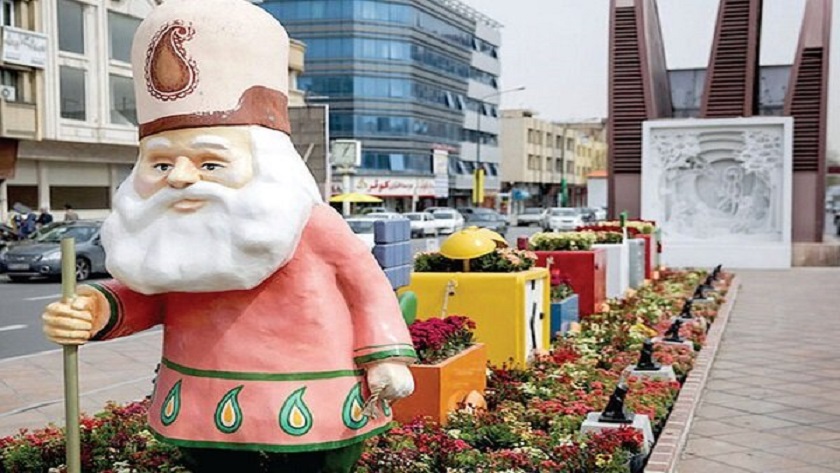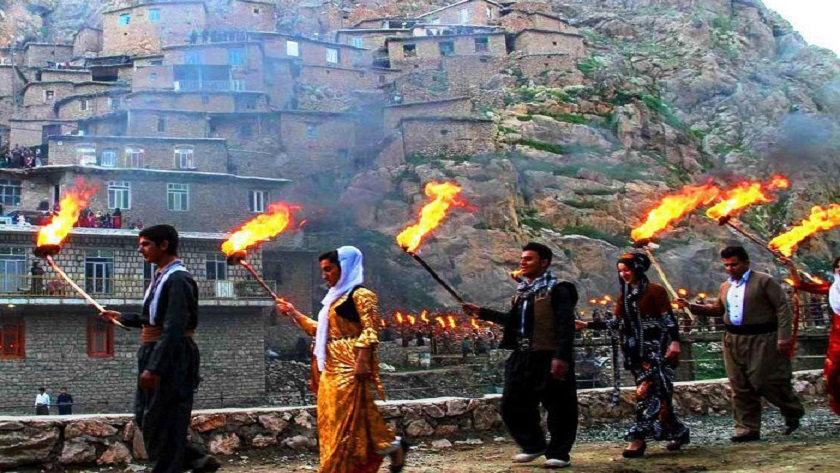Iran Press/ Iran News: Hajji Firuz and Amu Nowruz (Uncle Nowruz) are two very old figures surviving to us from ancient Iranian culture who herald the coming of spring and arrival of more light and end of cold winters with their long dark nights by chanting delightful songs and dancing lightly on streests.
 Hajji Firuz
Hajji Firuz
Hajji Firuz is a legendary figure in Iran who comes to the cities in the first days of every year with "Uncle Nowruz" to herald the arrival of Nowruz.
His appearance, which includes blackface, singing, and dancing, is an essential aspect of Nowruz festivities, but also controversial due to cultural insensitivity concerns.
Hajji Firuz is a well-known figure in Iranian culture, particularly during the annual celebration of Nowruz, the Persian New Year. He typically appears in public dressed in red and black, with his face painted black and wearing a hat or turban.
Hajji Firuz’s primary role during Nowruz is to entertain crowds through music, dance, and performance. He carries a tambourine and sings humorous songs and poems, often with bawdy or satirical content.
Hajji Firuz’s significance in Iranian culture is multifaceted. On one level, he represents the joy and celebration of the New Year, bringing laughter and merriment to the people. On a deeper level, some see him as a symbol of the struggle against oppression and injustice. According to legend, Hajji Firuz was a black-skinned slave who gained his freedom and became a beloved figure in Iranian culture.
In some sources, it is said that Hajji Firuz has its roots in the culture of Mesopotamia. Others consider it to be much older and date back to Babylon.
Whatever the origin and history of Haji Firuz and according to some sources "Haji Pirouz", it brings happiness and promises to people and is considered one of the important cultural symbols of Nowruz.
 Uncle Nowruz herlads spring in cities
Uncle Nowruz herlads spring in cities
Amu Nowruz (Uncle Nowruz)
This ficitional character is also one of the symbols of Nowruz in the belief of Iranian people who brings gifts to children on the nights of Nowruz celebration. Among the characteristics of Amo Nowruz, we can mention a white beard and fawn, a felt hat, a blue silk belt, a white shawl, and a thin flat veil.
Amu Nowruz or Uncle Nowruz is a legendary character originating in Iranian folklore. According to the folklore, he appears annually at the beginning of spring, together with his companion Haji Firuz, to mark the beginning of Nowruz, the Iranian New Year. According to some historians he symbolizes Zal, father of Rostam, the hero of Shahnameh.
He walks through the mountain, gets a staff and goes to the city gate. It is interesting to know that in Sistan region in the southeast of Iran, instead of Baba Nowruz, people believe in Bibi Nowruz (or Bibi Gol Afrooz).
There are various legends and stories about Uncle Nowruz. One of them is related to Uncle Nowruz and "Nene Sarma" (Mother of Cold). Nene Sarma goes as a symbol of stillness and freezing, and Uncle Nowruz arrives as a symbol of growth and newness.
 Nowruz celebration by Iranians in Kurdistan
Nowruz celebration by Iranians in Kurdistan
Nowruz rituals among Kurdish peoples in Iran
Among the Kurdish people, in addition to the traditional rituals of Nowruz, there are also different customs. In Iranian mythology, the origin of Nowruz is attributed to the enthronement of Jamshid, the mythical king of Iran.
But the Kurds consider Nowruz to be related to the story of the battle of Kaveh Ahangar (Iranian warrior) and Zahak (mythical oppressive king).
They believe that in Nowruz, when Kaveh won over Zahhak, people lit fire on the mountains and held hands to celebrate this victory. Since then, every year on the first day of spring, Kurdish people light fire and celebrate that auspicious day.
Nowruz among Azeri people
In addition to the Haft-sin Iranian table, which all Iranian people prepare for Nowruz celebration, Azeri-speaking peoples have a special table that is different from the table of other peoples, and these differences are also one of the beauties of Nowruz.
Azeri-speaking people remember the New Year with titles such as "Nowrouz Bayrami" and "Il Bayrami". During Nowruz Eid, they spread a white tablecloth called "Bayram Sofrasi" or "Yamish Sofrasi" in the guest room, and every guest who arrives sits on it and the owner of the house welcomes the guests.
This table is actually both a reception table and a Haft-sin table; Families also receive guests at the same table.
Read More:
Nowruz; victory of spring over darkness
Ashkan Salehian

